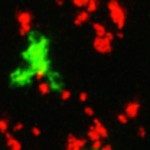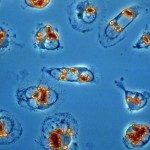Link to Pubmed [PMID] – 19616763
Cell Host Microbe 2009 Jul;6(1):23-33
CD4 T helper cells play a central role in the control of infection by intracellular parasites. How efficiently pathogen-specific CD4 T cells detect infected cells in vivo is unclear. Here, we employed intravital two-photon imaging to examine the behavior of pathogen-specific CD4 T cells at the site of Leishmania major infection. While activated CD4 T cells enter the inflamed tissue irrespective of their antigen specificity, pathogen-specific T cells preferentially decelerated and accumulated in infected regions of the dermis. Antigen recognition by CD4 T cells was heterogeneous, involving both stable and dynamic contacts with infected phagocytes. However, not all infected cells induced arrest or deceleration of pathogen-specific T cells, and dense clusters of infected cells were poorly accessible to migrating T cells. Thus, disparities in the dynamics of T cell contacts with infected cells and local variation in T cell access to infected cells are important elements of the host-pathogen interplay.




